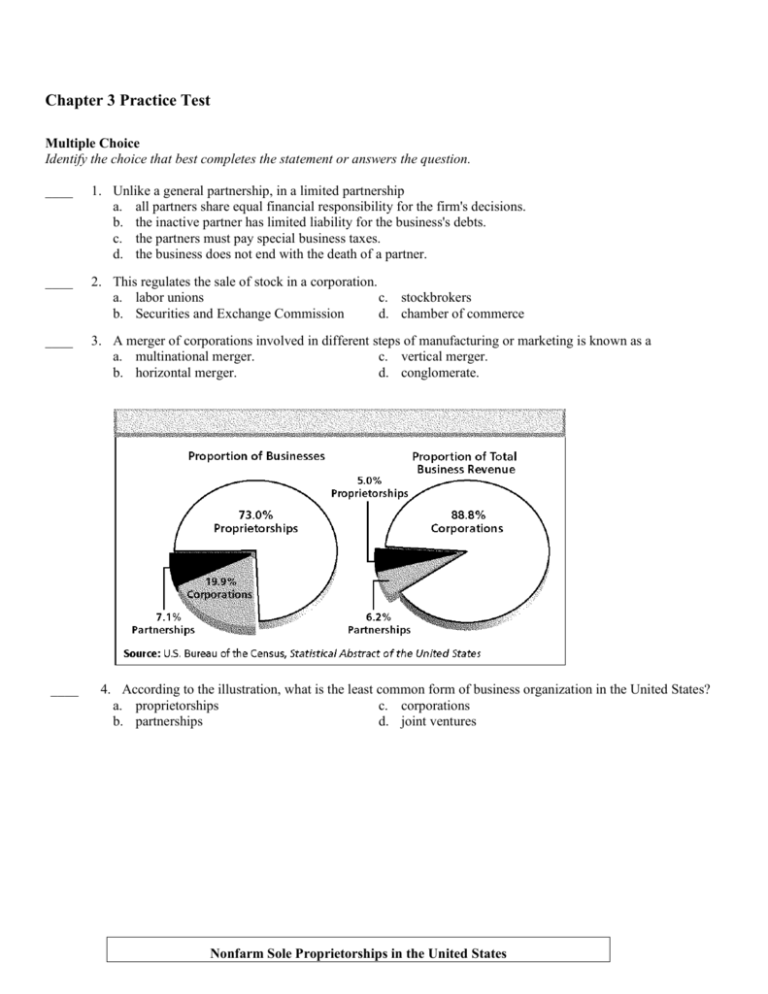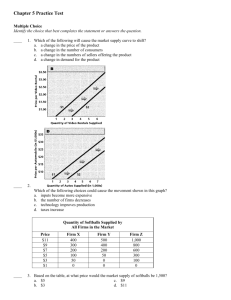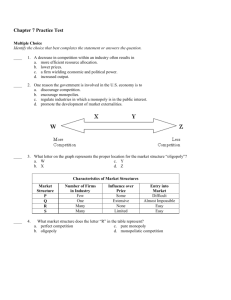Chapter 3 Practice Test: Business Organizations & Economics
advertisement

Chapter 3 Practice Test Multiple Choice Identify the choice that best completes the statement or answers the question. ____ 1. Unlike a general partnership, in a limited partnership a. all partners share equal financial responsibility for the firm's decisions. b. the inactive partner has limited liability for the business's debts. c. the partners must pay special business taxes. d. the business does not end with the death of a partner. ____ 2. This regulates the sale of stock in a corporation. a. labor unions c. stockbrokers b. Securities and Exchange Commission d. chamber of commerce ____ 3. A merger of corporations involved in different steps of manufacturing or marketing is known as a a. multinational merger. c. vertical merger. b. horizontal merger. d. conglomerate. ____ 4. According to the illustration, what is the least common form of business organization in the United States? a. proprietorships c. corporations b. partnerships d. joint ventures Nonfarm Sole Proprietorships in the United States (approximate figures) Total Number of Sole Proprietorships Percent of Sole Proprietorships Engaged in Different Types of Activities Total receipts (in millions) Net income (in millions) 16,154,000 Forestry and fishing Mining Construction Manufacturing Transportation Wholesale and retail Finance, insurance, real estate Services Other $790,630 $166,799 2% 1% 1% 3% 4% 18% 9% 50% 12% Source: Statistical Abstract of the United States. ____ 5. Based on the table, approximately what number of sole proprietorships are engaged in mining? a. 323,080 c. 1,615,400 b. 3,230,800 d. 161,540 ____ 6. In a general partnership, a. the business continues even if one partner dies. b. partners must pay specific business taxes. c. partners usually draw up legal papers called articles of partnership. d. partners are only liable for the business's debt up to the amount of their investment. ____ 7. In its direct role as an economic organization, American government a. regulates public utilities. b. acts as an umpire to make sure the market operates smoothly. c. owns and manages public utilities. d. makes grants to people in the form of Social Security. Partnerships, 1997-1999 Business Receipts Business Expenses Profit In billions of dollars 1997 $1,354 $1,186 X 1998 $1,603 $1,416 Y 1999 $1,907 $1,679 Z Source: Statistical Abstract of the United States, 2002. ____ 8. What number should appear in place of the X in the table? a. $2,540 c. $3,019 b. $187 d. $168 ____ 9. What type of merger does the illustration depict? a. horizontal merger c. diagonal merger b. vertical merger d. conglomerate Largest American-Owned Multinationals Revenue Rank/Company 1. Exxon 2. Ford Motor 3. IBM 4. General Motors 5. Texaco 6. General Electric 7. Citigroup 8. Wal-Mart Stores 9. Chevron 10. Hewlett-Packard Foreign ($mil) 143,044 51,691 51,180 48,233 43,146 42,390 37,396 32,100 31,374 27,230 Total ($mil) 206,083 170,064 88,396 184,632 60,220 129,853 111,826 191,329 69,058 48,782 Assets Foreign as % of Total 69.4 30.4 57.9 26.1 71.6 32.6 33.4 16.8 45.4 55.8 Foreign ($mil) 56,742 19,874 14,348 12,578 7,879 159,367 269,837 25,742 27,126 2,244 Total ($mil) 89,829 45,804 35,797 35,376 15,897 437,006 741,114 78,130 50,832 4,500 Foreign as % of Total 63.2 43.4 40.1 35.6 49.6 36.5 36.4 32.9 53.4 49.9 Source: Forbes, July 23, 2001. ____ 10. According to the table, more than half of the assets of which company or companies are located outside of the United States? a. Exxon b. Exxon, IBM, Texaco, Hewlett-Packard c. all of them d. Chevron, Exxon Chapter 3 Practice Test Answer Section 1. ANS: REF: 2. ANS: REF: B PTS: 1 DIF: Average Learn more about this question in Economics Principles and Practices, pages 64-65. B PTS: 1 DIF: Average Learn more about this question in Economics Principles and Practices, page 70. 3. ANS: REF: 4. ANS: REF: 5. ANS: REF: 6. ANS: REF: 7. ANS: REF: 8. ANS: REF: 9. ANS: REF: 10. ANS: REF: C PTS: 1 DIF: Challenging Learn more about this question in Economics Principles and Practices, page 75. B PTS: 1 DIF: Easy Learn more about this question in Economics Principles and Practices, page 64. D PTS: 1 DIF: Average Learn more about this question in Economics Principles and Practices, pages 62-64. C PTS: 1 DIF: Average Learn more about this question in Economics Principles and Practices, pages 64-66. C PTS: 1 DIF: Average Learn more about this question in Economics Principles and Practices, pages 82-83. D PTS: 1 DIF: Easy Learn more about this question in Economics Principles and Practices, pages 64-66. D PTS: 1 DIF: Average Learn more about this question in Economics Principles and Practices, page 76. D PTS: 1 DIF: Easy Learn more about this question in Economics Principles and Practices, pages 76-77.











